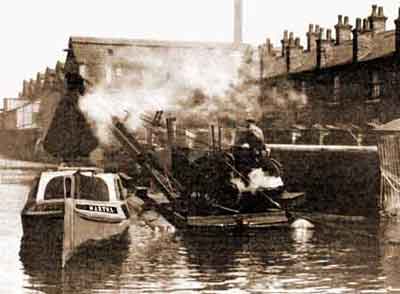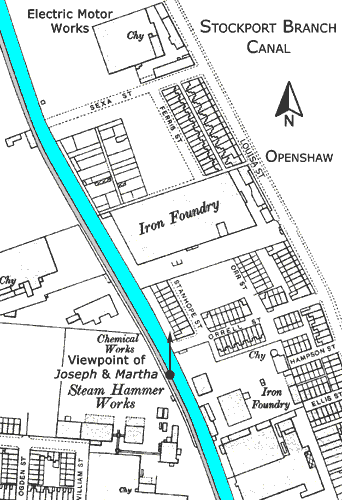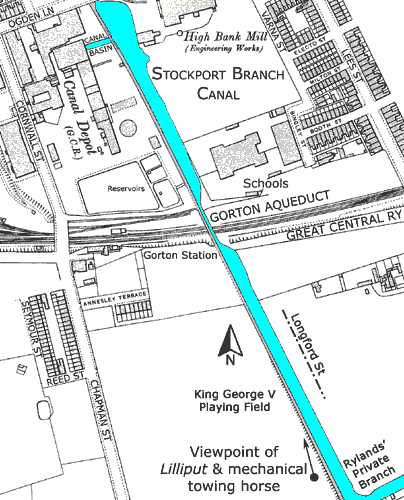
Nearly all of the canal network in Britain was nationalised on the 1 Jan 1948 (Transport Act, 1947. 10 & 11 George VI cap 49) and this came at a time when the prospects for the Ashton, Peak Forest and Macclesfield Canals were grim and those for the branches of the Ashton Canal in particular were even grimmer. It was a time when tried and tested equipment was being removed to be replaced once in a while by unfamiliar equipment, much of which was unsuitable for use on narrow canals.
Dredging at Openshaw before Nationalisation
The photograph below shows the steam dredger, Joseph, and maintenance boat, Martha, and
it was taken on the Stockport Branch Canal near an iron foundry to the south of the Electric Motor Works of Laurence Scott & Electromotors Ltd.
The viewpoint was some 790 yards from Clayton Junction, where the branch left the Ashton Canal. The terraced houses on the right of the photograph are on Stanhope St (later Standedge St).
The dredger, Joseph, was purpose built at the Gorton Canal Depot and worked so well that in 1916 it was taken away to work on the Chesterfield Canal, to return a year or so later. The Great Central Railway Co was also the owner of the Chesterfield Canal prior to nationalisation.

Stockport Branch Canal, Openshaw, before Nationalisation.
Left, the maintenance boat, Martha, & right, the steam dredger, Joseph.

Dredging at Gorton after Nationalisation
The bucket dredger, Lilliput, was introduced onto the Ashton Canal to replace the steam dredger, Joseph, which
had been taken away for service elsewhere, never to be seen again. Lilliput soon found itself on the Stockport Branch Canal and it is likely that this is where its short life ended.
In 1953 work commenced on resurrecting the then derelict Stockport Branch and passers-by at Hyde Road Bridge, Gorton, witnessed Lilliput clearing a channel through the canal by removing reeds that were choking it and dumping them onto the offside bank. It seems that very little of the spoil was removed by boat even though the dredger was accompanied by a shortened, square-ended narrow boat called Mary. In the event, this minimal work did not attract any traffic and before long the reeds were growing back again.
James 'Jim' Hirst was given the job of operating Lilliput and he complained that its buckets were forever falling off and that it constantly slopped dredgings over him. The day when protective clothing would be supplied was still some way off dawning. Additionally, Jim experienced problems with the engine of the dredger. It is likely that this odd-looking vessel was not capable of doing any serious work.
Jim kept a log of the work and his records show that dredging commenced in March 1953 in the vicinity of the Gorton Canal Depot progressing southwards towards Reddish. By August 1954, dredging had reached Longford Rd West, Reddish (not to be confused with Longford St, Gorton), a distance of 1.48 miles. At this juncture Jim’s log ends inferring that all work was officially stopped and that Lilliput and Mary had made their final journey back to the Gorton Canal Depot. The fate of Lilliput is unknown but it is understood that Mary may have been abandoned somewhere near the Gorton Canal Depot.
The origin of Lilliput is a mystery. It is not known who made it, from whence it came and even its name could have been a nickname given to it by maintenance staff. Associated with Lilliput another oddity that Jim was involved with on the Stockport Branch at this time was a mechanical towing horse, again of unidentified manufacture. The purpose of the mechanical towing horse was to tow Lilliput from Gorton Canal Depot to its place of work and then tow it back again at the end of the shift. The depot was situated on the far side of the railway line on the towpath side facing Varna St.
There is only one known photograph each of Lilliput and the mechanical towing horse and both were taken at the same location in Gorton, the viewpoint being some 1 mile 308 yards from Clayton Junction. These photographs have been joined together to produce a panoramic view of the scene, shown below, which is looking northwards towards Gorton Aqueduct over the main line of the former Great Central Railway.
The fenced area on the left of the photograph is King George V Playing Field, Gorton, and the terraced houses on the right are on Longford St. In the centre distance, beyond the terraced houses, part of the buildings of the schools in Bingley St (later Barrass St) can be seen. These schools are actually on the far (or north) side of the railway line and Gorton Station. The building on the right is part of Rylands' Mill. The mill formerly had its own private branch canal and this is off the photograph on the right. Lynton Caravans subsequently occupied the site of Rylands' Mill and they were still there in the 1970s.
Jim retired from his canal work in 1962 and, being a keen photographer, it was he who recorded these scenes on the Stockport Branch. His skills at canal work were sorely missed and soon after his retirement an inexperienced canal foreman took the maintenance boat Joel out from the Gorton Canal Depot. Thinking that he knew how to handle it properly, he managed to seize the engine somewhere near Guide Bridge on the Ashton Canal. Somehow, Joel was manhandled to the warehouse at Portland Basin where it was abandoned.

Stockport Branch Canal, Gorton, after Nationalisation. Left, the mechanical towing horse, & right, the bucket dredger, Lilliput.

Another item of unsuitable equipment, of which there is no known photograph, was a tug that was put into service on the Ashton Canal. Because of its deep draught it once got as far as Guide Bridge, with difficulty, where it ran aground because the canal was too shallow for it. There was no alternative but to haul it back to the Canal Depot and it was never seen again.
This particular tug had been brought in as a replacement for the maintenance boat Joel with the intention of using it to tow the three surviving, but semi-derelict, horse-drawn boats, Maria, Dove and Medic. Now and again, minor leaks in the canal required repair and these three boats were still sufficiently serviceable to carry clay for puddling purposes.
The second replacement for Joel was a bantam-style tug that was not designed for use on narrow canals, being a little larger than subsequent purpose-built tugs. Its draught exceeded three feet and, considering the poor condition of the canals, it could not float properly. This tug also ended its days in the warehouse at Portland Basin and by around 1970 it had disappeared.
In the end, it became the job of workmen to pole maintenance boats along the canal and now and again one could be seen making about one mile per hour along the Ashton Canal.
Viable commercial carrying on the Stockport Branch had, to all intents and purposes, ceased in the 1930s, although its water was still used by the many mills and factories that lined its banks. The first casualty was Stockport Basin, which was closed and then filled in to leave Wharf St as the only visible reminder of the canal's former presence at Stockport. In 1962, after lingering on since the early 1950s, the branch was at long last officially declared to be dead but for people who lived nearby, its burial proved to be extended and for the most part, disagreeable and difficult.